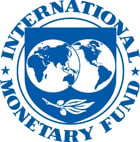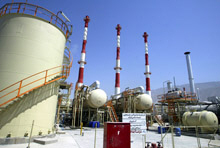
Typical street scene in Santa Ana, El Salvador. (Photo: iStock)
IMF Survey: Iran to Cut Oil Subsidies in Energy Reform
September 28, 2010
- Reform should remove distortions and restore efficiency in the economy
- Aim is to export more oil and thus generate more revenue
- Government to redistribute to the people the additional revenue earned
In the past three months, the Islamic Republic of Iran has begun eliminating energy subsidies, a move that could transform the way the country’s economy works and influence reform in other energy-producing countries, IMF economists say.

Gas field in Assaluyah, Iran: The country’s energy price reform is expected to curb the wasteful use of energy, among other benefits (photo: AFP/Atta Kenare)
ENERGY PRICE REFORM
With the removal of subsidies on oil and gas, domestic demand for energy in Iran is expected to decline, leaving more energy resources available for export. If all goes according to plan, the strategy should serve the dual purpose of generating more revenue for the country and curbing the wasteful use of energy, IMF mission chief Dominique Guillaume and Senior Economist Roman Zytek told the IMF Survey online.
The country’s energy price reform comes at a time when the United Nations Security Council and a number of countries are imposing economic sanctions targeted at Iran’s nuclear program.
In an interview, Guillaume and Zytek spoke about the reasons behind Iran’s upcoming energy price reform and the benefits it could yield.
IMF Survey online: Can you paint a picture of the Iranian economy today?
Guillaume: Iran is the 17th largest economy in the world. Holding little foreign debt—less than 7 percent of GDP—the country has sizeable energy reserves, with underground hydrocarbon resources estimated at $10 trillion in oil alone (at $75 a barrel) and natural gas reserves at between $3½-4½ trillion.
Real GDP growth is estimated to have been about 1-2 percent this year. This relatively low GDP growth is due mainly to weak domestic demand, since Iran’s integration with global financial markets is limited. Inflation has declined dramatically—from close to 30 percent two years ago to less than 10 percent since September 2009 as the central bank withdrew liquidity. This lower level of inflation provides a good foundation for the energy price reform. Eliminating energy subsidies means that the Iranian people will see an increase in prices, so it’s important to have low inflation to start with.
IMF Survey online: Why are oil and gas subsidized in the first place?
Zytek: The government believed, at one time, that subsidies were the best way to distribute national wealth. The price just had to cover the cost of extraction. This was less of an issue when the international prices were low, and the price differential between the extraction cost and the international price was small. But this is no longer the case. International prices for oil and gas, especially oil, have surged, reaching almost $150 per barrel in 2008, and the extraction cost is a small fraction of this, at roughly $5 to $10 a barrel. So giving away for free something that could be sold for a pile of money is not the best policy.
IMF Survey online: If Iran sold more oil and gas on international markets, would that generate a lot more revenue than if they sold it domestically?
Zytek: Yes. At such low prices, domestic demand for energy in Iran has grown very rapidly, and it is increasingly difficult to have energy resources available for export. With the price reform, you will dampen domestic demand, which means more efficient energy use domestically, more energy available for profitable exports, and higher revenues for the country.
IMF Survey online: How much does the current subsidy amount to?
Zytek: The value of subsidies varies depending on the price of oil. Until recently, a household of four in Iran gets on average about $4,000 a year in various subsidies on oil and natural gas alone. By comparison, many Iranians may earn about $300 a month, or $3,600 a year. The government has already started reducing the subsidies, however, by halving the gasoline ration sold at extremely low prices. Other energy products have so far remained very cheap.
IMF Survey online: What’s so bad about the subsidy?
Zytek: When something comes cheaply, people buy as much of it as possible, which leads to inefficient use of the resource. Moreover, the subsidy benefits those who use energy the most—the rich fellow with a sports utility vehicle, a 7,000 square foot air-conditioned house, and several large appliances. The $4,000 subsidy is an average—the poor, who use much less energy, get very little subsidy.
IMF Survey online: What has prompted the government to get rid of the subsidies?
Guillaume: The main reason is to eliminate the huge negative impact on the economy of this extremely cheap energy. In the 1980s, Iran was one of the most energy-efficient countries. Now, it’s one of the most wasteful. When you set foot in Tehran, you realize it immediately. Some days you can’t even see the beautiful mountains surrounding the city because of the pollution.
The government realizes that the distortion in the demand and supply for energy is so serious that if they don’t restore the balance, the country will never achieve its high-growth potential. The government is aiming to grow at the pace of South Korea and other vibrant emerging market countries, and they realize that the only way to do so is to restore market pricing of energy.
IMF Survey online: Has the proposal for the elimination of subsidies been adopted as law?
Guillaume: It was approved by Parliament and signed into law this past January, after more than a year of debate. The discussion was not on whether or not to introduce the reform—most people agree it’s a good idea. It was more about the details—how fast you go and how you compensate different groups of the population.
The law doesn’t specify the price increase for the first year; it specifies that the objective will be the quasi-elimination of subsidies on par, more or less, with the international f.o.b. price. And it also specifies a revenue target of $20 billion for the first year, which you can translate into a certain increase in prices.
IMF Survey online: What measures will the government take to soften the impact on citizens?
Guillaume: We are talking about a very big price increase—potentially of between 4 and 20 times for some energy products in the first move. Over time, it will have to amount to even more, unless international prices fall. This, of course, creates some concerns. But the law gives some parameters for the redistribution of the additional revenues that the reform will generate: 50 percent of it will go back to households in the first year, all in cash. They’ll be fully compensated, and they’ll have the choice to buy what they want with it.
Businesses are also going to get some support: 30 percent of the additional revenues will go to them. This money is meant to help companies invest in energy-efficient technologies. The reform has been discussed for a few years, so that businesses have had time to plan for the adoption of new technologies. Heavy industry will take more time to adjust than the service sector, but companies are receiving support to adapt to ensure that the transition is as smooth as possible.
Then, the government will receive the remaining 20 percent to pay for their higher energy bill. The key is to ensure that these plans will be operational and effective from day one.
IMF Survey online: What are some of the other benefits of eliminating the energy subsidy?
Guillaume: From a domestic perspective, if prices are higher, the energy sector in Iran will become more profitable and hence be able to invest, extract, and produce more. Furthermore, if the Iranian people are able to restrain their consumption, this will have a positive side effect on the global oil market.
Zytek: This will also push the domestic automobile industry to modernize itself. The country produces about 1.5 million cars per year, targeting the domestic market of 74 million people. Since gasoline is almost free, carmakers have little incentive to make their product energy efficient. But when gasoline price rises to the international level, Iranian car manufacturers will have to change the way they operate and increase the energy efficiency of their vehicles. Once this happens, Iranian-made cars will be more competitive on the export market.


